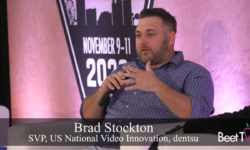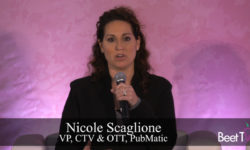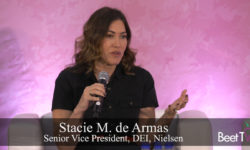SANTA MONICA — Data-driven and automated selling of streaming TV ads is growing.
But if programmatic wants to hit higher heights in tv, it will have to shake-off its origin story.
That is according to one TV ad-tech exec in close contact with money movements.
Programmatic take-off
“Programmatic wasn’t built for premium video – it was built for digital display,” says Katy Loria, US chief revenue officer or FreeWheel, the Comcast-owned company providing ad platforms for publishers, advertisers and media buyers.
That history, also called “baggage” by Loria, has its up sides.
“We know what not to do,” she says. “Bad traffic, brand safety, viewability, the race to the bottom, opaque tech tax commoditization. Those are the pitfalls that we have to avoid as we build this ecosystem because the concerns are the same.
“If we really work to resolve old and new issues, if we pave the way, content publishers and distributors will have the runway, the confidence to move into programmatic.”
Growth forecast
EMarketer had forecast US spend on connected TV (CTV) ad channels via programmatic methods would hit $14.3 billion in 2022).

That is actually the slowest growth in the method seen in years, but it is a channel that is maturing, as more ad buyers switch on to the new channels and new capabilities on offer.
It is about 20% of the total $68.35 billion US TV ad spend eMarketer forecast separately for 2022.
Working hard
At FreeWheel, Loria has a close read on the platform’s own numbers.
“We see three billion ad impressions daily,” she says. “Twelve to 15% of that is transacted programmatically … a relatively small percentage of that being transacted programmatically. So that says to me, it’s early days.
“That’s really exciting. Programmatic ad spending in the premium space is growing. Budgets are rising, more inventory is being made available, more is transacting in the upfront. The advertiser base is growing.
“So the experimental stages of CTV programmatic premium video is well underway. So I think the future is bright. We believe that, if we do build that healthy ecosystem, that 15% will grow to 50% by the year 2026. That’s worth working hard for.”
Growing the pie
The key question for people in the connected TV (CTV) space is: “How do we grow that proportion?”
Programmatic tech has not come to TV in the same way it started in display – that is, by playing in the remnant-inventory, auction space. TV is a much more premium space that would never tolerate such a norm.
But that doesn’t mean the new channel doesn’t face its own challenges. Steadily, concerns about pod placement, viewer experience, competitive separation, fraud and more have grown in programmatic TV, too.
“We really need to build an ecosystem where sellers trust that their inventory is being represented and monetized in the right way,” says . And in that same ecosystem buyers trust what’s being delivered and how it’s being counted.
“So when we get to that point with trusted solutions in place – premium publishers who, for many, many, many years have relied solely on direct sold – we’ll have the confidence to move more to programmatic and to that unified supply.”
You are watching coverage of Beet Retreat Santa Monica 2022, presented by Ampersand, MiQ, Nielsen, PubMatic, T-Mobile Advertising Solutions and The Trade Desk. For more videos from the Beet Retreat, please visit this page.














































